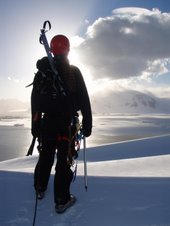The joys of nightshift. Should you ever find yourself in a situation where you have to mind an Antarctic station alone, and have pretty much zero contact with any other human being for over a week at a time, may I offer a few lessons learnt? Firstly, although Kubrick is the master of all cinema do not watch the film ‘A Clockwork Orange’. Dark, empty bases in the deep of winter during nights are enough in themselves to disturb the psyche, do not add the psychological trauma of Kubrick’s violent classic on top. Also watching ‘Blue Velvet’ is a no-no. The last thing you need while running the rounds with a torch beam sharply cutting into the darkness is the mental image of Anthony Hopper with the methanol mask scene in your mind.
Now, here is a scenario for you. Imagine walking down a rickety old wooden corridor between various outbuildings, and you notice a very small piece of pipe work in the side of wall. Do you:
A. Pretty much ignore it and carry on walking, or
B. Get down on your hands and knees and start sniffing it.
The answer is A. It’s A because you are not deranged...
Now imagine the same situation, only this time you see this message each time you pass the aforementioned pipe. Have you ever seen a more ridiculous sign?
Now, here is a scenario for you. Imagine walking down a rickety old wooden corridor between various outbuildings, and you notice a very small piece of pipe work in the side of wall. Do you:
A. Pretty much ignore it and carry on walking, or
B. Get down on your hands and knees and start sniffing it.
The answer is A. It’s A because you are not deranged...
Now imagine the same situation, only this time you see this message each time you pass the aforementioned pipe. Have you ever seen a more ridiculous sign?

I had to walk through this passageway three times a night as part of the rounds, and now the ONLY thought that goes through my head as I pass is to sniff the thing.
On the plus side, any room is game for a surrogate office, and lets face it, no plush corner office in any skyscraper can beat a British base bond booze room!
On the plus side, any room is game for a surrogate office, and lets face it, no plush corner office in any skyscraper can beat a British base bond booze room!

Plus there’s always the constant excitement in the risk of getting caught chatting to Argentinean taxi drivers on short wave!

But the results from those conversations really warrant an entire new subject in mind sciences, let alone a separate blog entry.








